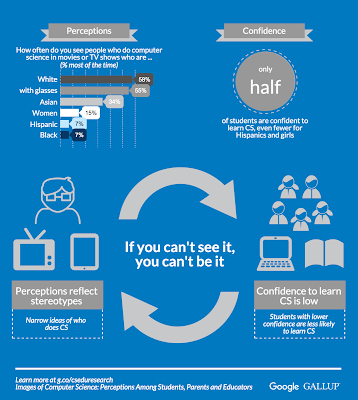Editor's note: Positive perceptions of Computer Scientists make CS Education more inclusive, accessible and identifiable to all students. If you’re ready to start your first Hour of Code during CSEdWeek 2015, check out Google’s High Seas and Inside Out introductory Hour of Code activities.
My TV hero growing up had red hair, wore awesome outfits, and taught science to a diverse group of students. You guessed it, she’s Ms. Frizzle aka The Frizz from PBS’s The Magic School Bus! Her mantra was “Take chances, make mistakes and get messy. It’s the only way you learn.” That mantra is particularly relevant in the world of technology and computer science (CS), and here at Google we are continually trying new, sometimes crazy ideas, and learning from our successes and from our failures. But, what if Ms. Frizzle had never existed?
Close your eyes. Think of your favorite TV show or movie. Is there a scientist, a hacker or, more specifically, a computer scientist in it? What do they look like? Chances are, they are male, white or Asian, wear glasses, and are portrayed as nerdy and anti-social. Based on analysis from the Geena Davis Institute (GDI), only 11% of family films, 19% of children’s shows and 22% of prime-time programs feature women and men equally in speaking parts. Combine these staggering statistics with an overall dearth of CS characters on-screen (see chart below), and it’s no wonder we all think of the same stereotypical image for a programmer.
Why is this a problem? As Google’s Women Who Choose CS--What Really Matters study and the recently published Google-Gallup report, Images of Computer Science: Perceptions Among Students, Parents and Educators in the U.S. found, perceptions of careers in computer science really matter. On-screen stereotypes of those who engage in CS persist as do students’, parents’, and educators’ personal perceptions leading to particularly girls and underrepresented boys not seeing themselves in the field- or in other words, if you can’t see it you can’t be it.
At Google we believe we have a role to play in bridging this gap, which is why we’ve assembled a team that is focused on making CS more appealing to a wider audience, by dispelling stereotypes and showcasing positive portrayals of underrepresented minorities in tech. We are working hand-in-hand with writers, producers, networks, studios, and our own YouTube team to create new and diverse storylines about the limitless creative opportunities computer science provides. This is an opportunity to lift back the curtain on tech and feature stories that all too often go untold.
We’ve partnered with writers and producers of a variety of shows, including ABC Family’s The Fosters, Disney Jr’s Miles from Tomorrowland, FOX’s Empire and HBO’s Silicon Valley to bring the voices of real-life diverse software engineers to the screen. We also premiered award-winning director Lesley Chilcott’s newest film, CodeGirl, on YouTube for free for five days garnering almost 1M views. Great partners like Geena Davis Institute, Paley Center for Media, Campus Movie Fest and others are raising awareness of these issues and helping to move the needle on diversity in Hollywood.
We’re excited to join YouTube Kids in celebrating Computer Science Education Week with a curated playlist (on the YouTube Kids app) of Google engineers’ favorite CS content, including a special piece celebrating Ada Lovelace’s 200th birthday (Today, Dec. 10th). We hope Ada will inspire budding programmers everywhere so over on YouTube Kids we’re bringing her story to life with a little help from Presley at Act Out Games and Inklings Creative. Who is Ada Lovelace, you might ask? Well, you’ll have to watch the short film to find out!
Celebrate Ada’s contributions to CS by sharing the short with friends and family and join us in changing the face of CS one image at a time.
Ideally, one day all students will have an inspiring role model that they can relate to and that encourages them to “take chances, make mistakes and get messy!” It really is the only way to learn.














